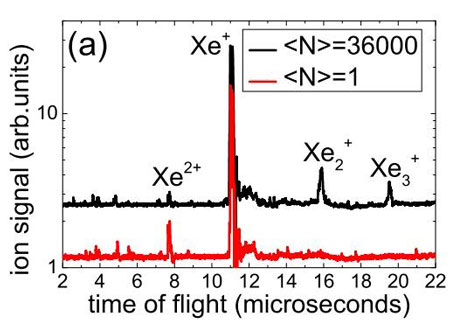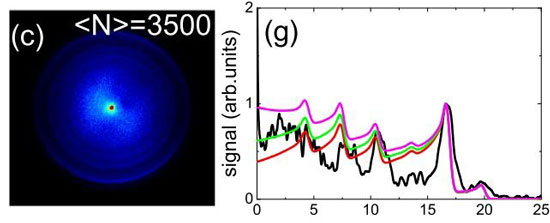| Feb 24, 2014 |
Revealing secrets of exploding clusters
|
|
(Nanowerk News) The investigation of cluster explosion dynamics under intense extreme-ultraviolet (XUV) pulses has so far been limited to large scale facilities like free-electron lasers. In a recent publication it was shown that the research on clusters is now also possible with intense XUV pulses obtained in a laboratory-scale environment with a newly developed light source that makes use of the high-order harmonic generation process. For the first time, the formation of high-lying Rydberg atoms by electron-ion recombination during the cluster expansion initially triggered by an intense XUV pulse was identified, giving new insight into the cluster dissociation process.
|
 |
| Time-of-flight spectrum for xenon atoms and clusters with an average size of 36000 atoms. For clusters, larger fragments like dimers and trimers are observed. In comparison, the ratio of Xe2+/Xe+ is smaller for clusters than for atoms, which is attributed to recombination processes taking place in the cluster nanoplasma.
|
|
An intense light pulse interacting with a weakly bound van der Waals cluster consisting of thousands of atoms can eventually lead to the explosion of the cluster and its complete disintegration. During this process, novel ionization mechanisms occur that are not observed in atoms. With a light pulse that is intense enough, many electrons are removed from their atoms that can move within the cluster, where they form a plasma with the ions on the nanometer scale, a so called nanoplasma. Due to collisions between the electrons, some of them may eventually gain sufficient energy to leave the cluster. A large part of the electrons, however, will remain confined to the cluster.
|
|
It was theoretically predicted that electrons and ions in the nanoplasma recombine to form Rydberg atoms, however, an experimental proof of this hypothesis is still missing. Previous experiments were carried out at large scale facilities like free-electron lasers that have sizes from a few hundred meters to a few kilometers showing already surprising results such as the formation of very high charge states when an intense XUV pulse interacts with the cluster. However, the accessibility to such sources is strongly limited, and the experimental conditions are extremely challenging. The availability of intense light pulses in the extreme-ultraviolet range from an alternative source is therefore important to gain a better understanding of the various processes occurring in clusters and other extended systems such as biomolecules exposed to intense XUV pulses.
|
 |
| Left side: 2D electron momentum map of argon clusters with an average size of 3500 atoms showing a pronounced central distribution attributed to the ionization of Rydberg atoms with the detector field. Right side: The electron kinetic energy spectrum (black curve) shows a good agreement with numerical calculations, which are displayed for intensities of 5x1011 W/cm2 (red), 1x1012 W/cm2 (green) and 2x1012 W/cm2 (violet).
|
|
Scientists from the Max-Born-Institut have developed a new light source that is based on the process of high-order harmonic generation. In the experiment, an intense pulse in the extreme-ultraviolet range with a duration of 15 fs (1fs=10-15s) interacted with clusters consisting of argon or xenon atoms.
|
|
In the current issue of Physical Review Letters ("Rare-Gas Clusters in Intense Extreme-Ultraviolet Pulses from a High-Order Harmonic Source ") Bernd Schütte, Marc Vrakking and Arnaud Rouzée present the results of these studies, which are in very good agreement with previously obtained results from free-electron lasers: the formation of a nanoplasma was inferred by measuring the kinetic energy distributions of electrons formed in the cluster ionization process, showing a characteristic plateau up to a maximum kinetic energy given by the kinetic energy resulting from photoionization of an individual atom.
|
|
In collaboration with the theoreticians Mathias Arbeiter and Thomas Fennel from the University of Rostock, it was possible to numerically simulate the ionization processes in the cluster and to reproduce the experimental results. In addition, by using the velocity map imaging technique, a yet undiscovered distribution of very slow electrons was observed and attributed the formation of high-lying Rydberg atoms by electron-ion recombination processes during the cluster expansion. Since the binding energies of the electrons are very small, the DC detector electric field used in the experiment was strong enough to ionize these Rydberg atoms, leading to the emission of low energy electrons. This process is also known as frustrated recombination and could now be confirmed experimentally for the first time.
|
|
The current findings may also explain why in recent experiments using intense X-ray pulses, high charge states up to Xe26+ were observed in clusters, although a large number of recombination processes is expected to take place. Moreover, the opportunity to carry out this type of experiment with a high-order harmonic source makes it possible in the future to perform pump-probe experiments in clusters and other extended systems with a time resolution down to the attosecond range.
|


